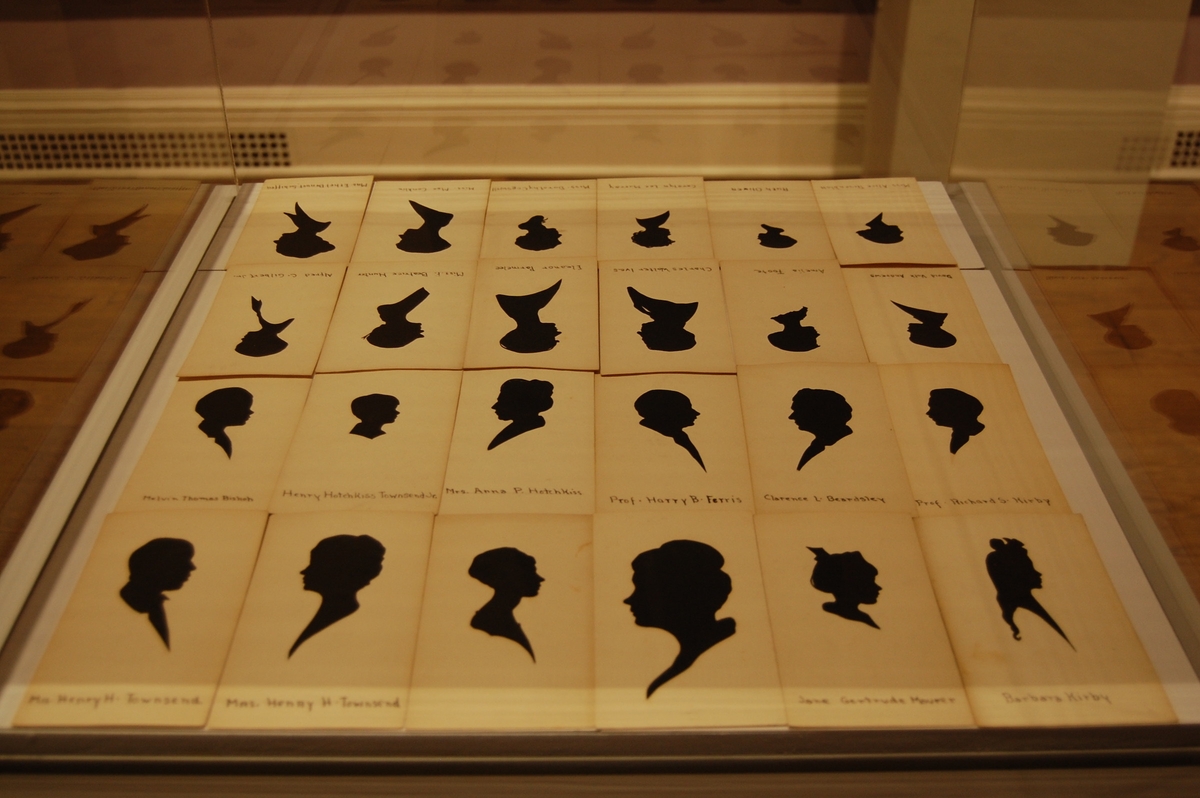
Eleanor Polak Photos
Ruth McInton Cogswell's silhouettes of New Haven characters.
“Profiles: Ruth McInton Cogswell and Dorothy Cogswell” — the latest exhibition at the New Haven Museum at 144 Whitney Ave. — highlights the lives and work of two women who played an important role in the Elm City’s early 20th-century local art scene. The mother-daughter duo of artists used watercolors, pencil drawings, and silhouettes to pay tribute to the people of New Haven and commemorate their history. Through the Cogswells’ work, the show provides a tour of the city’s past, where viewers can recognize familiar figures and learn new aspects of their history.

Eleanor Polak Photos
Photograph of Dorothy Cogswell in 1948.
Ruth McInton Cogswell (1885 – 1944) grew up in New Haven and attended the Yale School of Fine Arts. A respected art teacher and artist, Ruth worked in a variety of mediums, including her primary passion, the art of silhouettes. She founded Cogswell Studio, which offered art classes to students of different ages and levels of experience, where her daughter, Dorothy, also worked. Dorothy Cogswell followed in her mother’s footsteps as both a teacher and an artist, attending the Yale School of Fine Arts and becoming the first woman to receive an MFA from Yale in 1939.
Rather than pitting the two women against each other, the exhibition encourages viewers to see their work as two halves of a shared artistic goal: to represent the residents of New Haven through their delicate and realistic portraits.

Eleanor Polak Photos
Bernice Segaloff, by Ruth McInton Cogswell (left) and Dorothy Cogswell (right).
On one wall, a side-by-side comparison of two portraits of Bernice Segaloff — one by Ruth and one by Dorothy, both in 1935 — highlights the similarities and differences in their styles. Both renditions use pencil lines to create an affectionate and palpably soft depiction of Segaloff. However, Dorothy’s version looks significantly younger than Ruth’s, posing the interesting question of how each woman related to their subject.

Eleanor Polak Photos
Silhouettes patterns showing the double cutting process, by Ruth McInton Cogswell.
Ruth’s silhouette work takes up a large portion of the space. Numerous miniatures of outlined black figures line the walls and collect in glass cases like a stamp collection. A silhouette refers to an image of a person in one solid color, usually a profile hand cut from paper or board. They became popular in the 19th century due in part to the influence of French artist Auguste Edouart. In a laminated version of a handwritten essay entitled “The Cut of Silhouettes,” Ruth writes that “The silhouette at its best should, in its purity and artistry of outline above, suggest a true and characteristic portrait.”
Ruth’s silhouettes appear delicate yet defined, the firm lines displaying a certainty that isolates a person from their surroundings to show their distilled character. Many of Ruth’s works portray families or children, intimate representations of loved ones that can, in their small scale, be kept close to the heart. They reflect a deep love for the New Haven community as an amalgamations of individuals, each one reduced to the simplest expression of personality through the turn of a nose or the flick of an eyelash.

Eleanor Polak Photos
Beatrix Sherman's silhouettes of Clarence and Dorothy Cogswell.
Dorothy Cogswell provided much of the material in the exhibition when she donated it to the New Haven Museum in the early 1980s. In an accompanying correspondence quoted on the wall of the gallery, she detailed her mother’s artistic technique: “She cut them double and kept on as a record, not only signing it but asking the sitter to sign it too.”
“In other words,” reads the museum’s commentary, “Ruth would fold a single piece of paper in half, cut the profile, and when the paper was unfolded, there were two silhouette portraits.” Ruth became interested in silhouettes after a visit to artist Beatrix Sherman in 1916, when Sherman created silhouettes of Dorothy as well as Ruth’s husband, Clarence. The result, included in the exhibit, contrasts childhood vivacity with adult poise using little more than the outlines of clothing and postures.

Eleanor Polak Photos
Silhouettes by Barbara Lewis Hewlett, Carol May Kulp, and Ethel Swain Hurlburt.
The exhibit also includes samples of work from Dorothy’s and Ruth’s students at the Cogswell Studio. From 1929 – 1931 the pair ran a colony for young women “to experience the happiness that comes from sympathetic understanding and appreciation of the beautiful,” reads an accompanying plaque. Several of their students, such as Barbara Lewis Hewlett, Carol May Kulp, and Ethel Swain Hurlburt, followed in Ruth’s footsteps creating silhouette scenes of children and animals straight out of a fairytale book.
A profile can mean a description summing up a person’s life or an outline of a face tilted to the side. In this exhibit, it means both. Viewers can learn about the legacy of Ruth McInton Cogswell and Dorothy Cogswell while appreciating the intimate portraits they created of themselves and the people they knew. Either way, they learn to see the history of New Haven through the eyes of two important women — a history centered on the people, bold and dark, silhouetted against the white canvas of passing time.